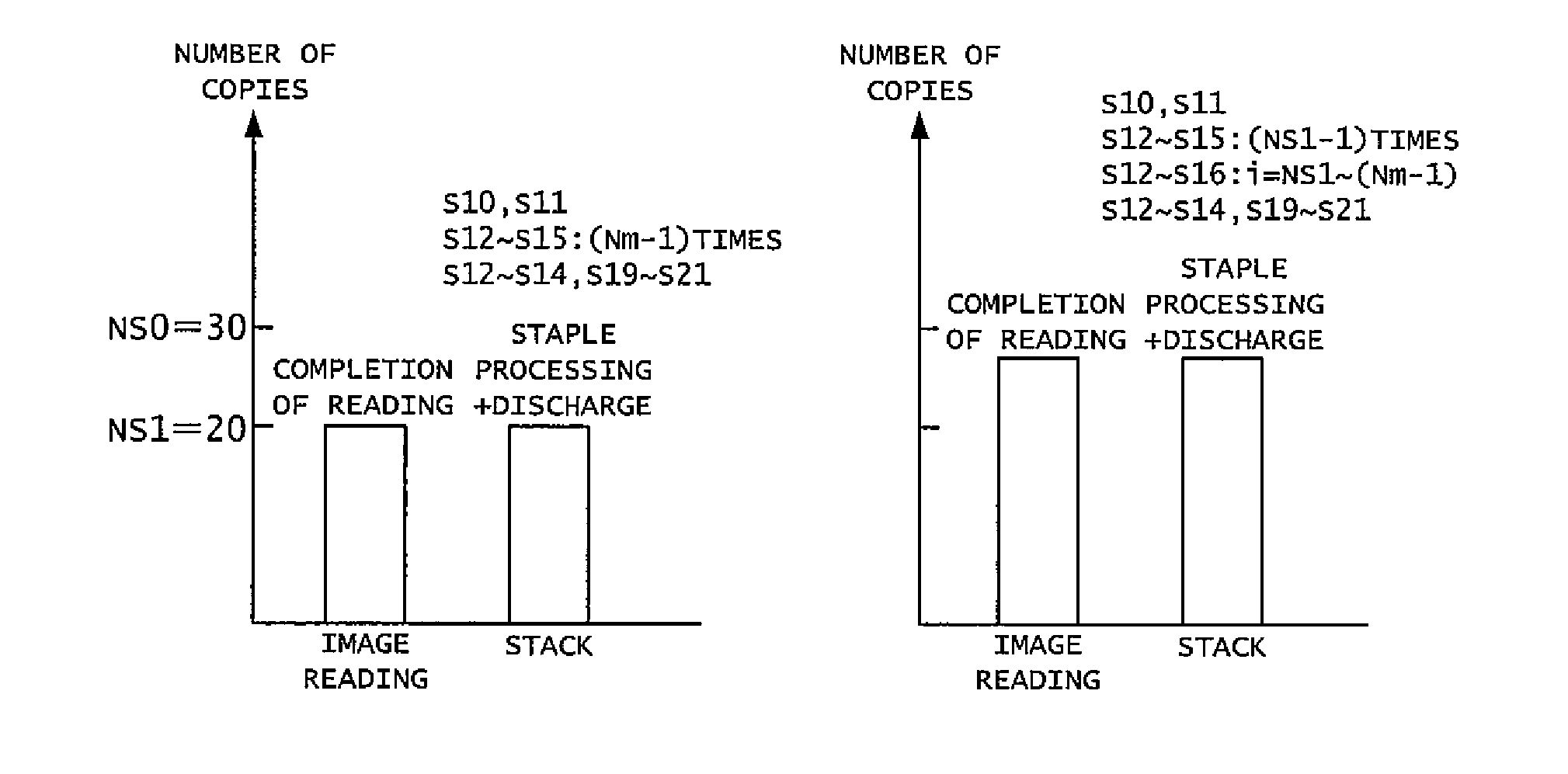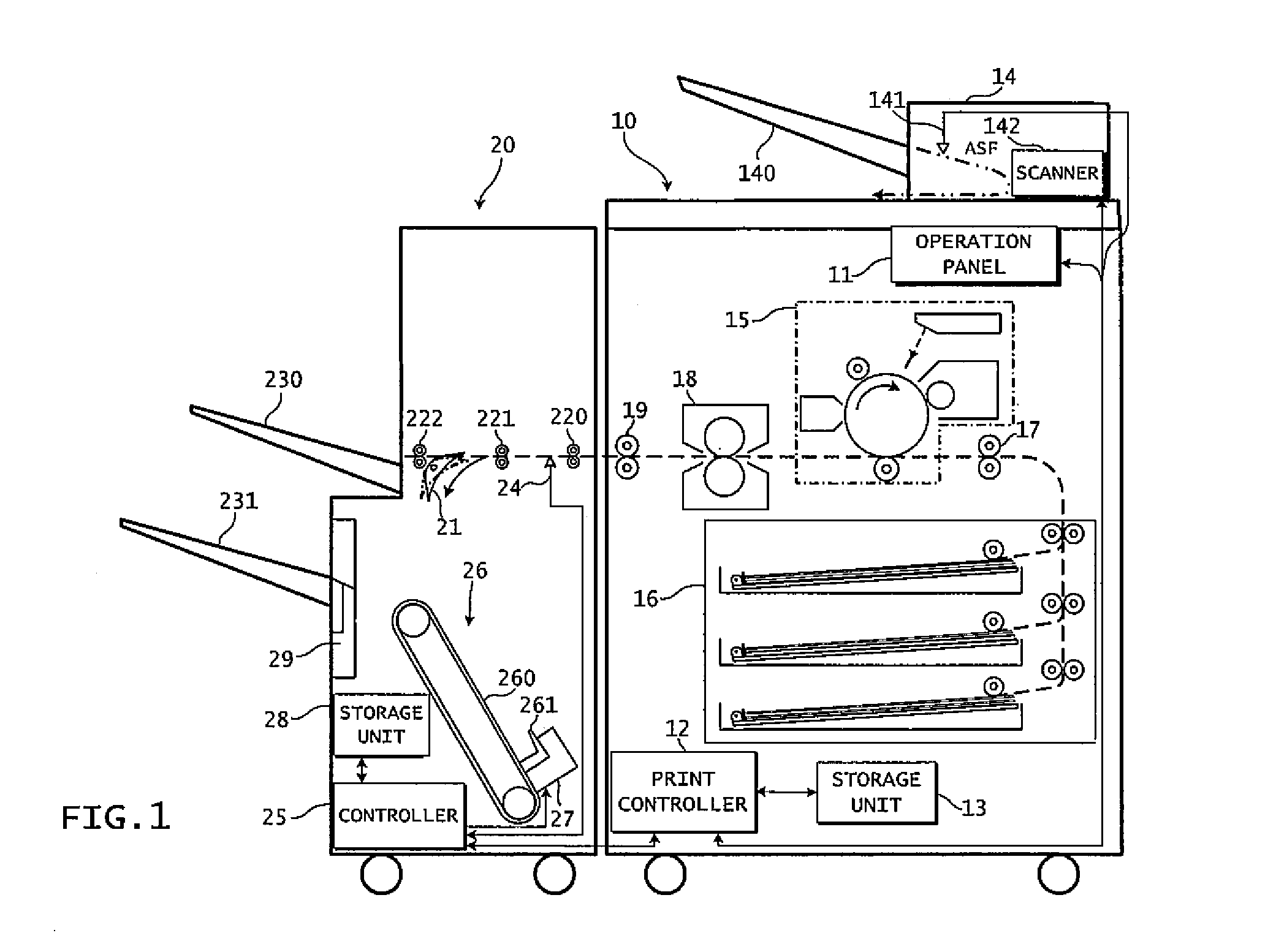Image forming system including finisher with stapler for binding printed papers
a technology of image forming system and finisher, which is applied in the direction of electrographic process, transportation and packaging, instruments, etc., can solve the problems of inability to bind, easy scattering of copies, and stagnation of subsequent printing or copying
- Summary
- Abstract
- Description
- Claims
- Application Information
AI Technical Summary
Benefits of technology
Problems solved by technology
Method used
Image
Examples
first example
[0035]An upper limit number NS0 of the staple processing and a set number NS1 are stored in the storage unit 28. Concrete values of the upper limit number NS0 and the set number NS1 are determined in advance according to the type and size of papers. In particular, the upper limit number NS0 is determined based on the capacity of the stopper 261. Further, the set number NS1 is such a value that a bundle of copies in this number is assumed not to cause a jam when discharged from the stacker 26 to the tray 231 without being stapled, and this value is smaller than the upper limit number NS0. For example, in a case where the type of a paper used for copying is “plain paper” and the size thereof is B4, the upper limit number NS0 is set to 30 in advance. The set number NS1 corresponding thereto is 20. Alternatively, in a case where the type of a paper is “plain paper” and the size thereof is A4, the upper limit number NS0 is set to 50 in advance. The set number NS1 corresponding thereto is...
second example
[0095]Next, copy processing of a second example will be described. FIG. 6 is a flowchart showing this processing. This processing is started when the start key of the panel 11 is pressed.
[0096](S100) An initial value 0 is substituted in the count N of the number of originals.
[0097](S101) If the paper sensor 141 has detected an original, the flow goes to Step S102, and if not, the flow goes to Step S110.
[0098](S102) If the count NX of image formed papers is equal to the upper limit number NS0, the flow goes to Step S103, and if not, the flow goes to Step S104. In a usual case, the count NX is equal to the count N, but as in the above-described first example, NX=[(N−1) / 4]+1 in the 4-in-1 integration processing. Also in the second example, in a case where NX=NS0, it is determined as NX>NS0 since the existence of an original has been determined at Step S100.
[0099](S103) Staple processing which has been selected is cancelled and this is notified to the controller 25. In response to this ...
third example
[0117]Next, copy processing of a third example will be described. FIG. 8 is a flowchart showing this processing. This processing is started when the start key of the panel 11 is pressed.
[0118](S200) An initial value 0 is substituted in the count N of the number of originals.
[0119](S201) If the paper sensor 141 has detected an original, the flow goes to Step S202, and if not, the flow goes to Step S204.
[0120](S202) The ASF 14 is operated to feed one sheet of the original, and the scanner 142 scans an image thereof. Then, image data from the scanner 142 is tentatively stored in the storage unit 28.
[0121]If N=1, in order to execute processing at Step S205 and processing at Step S206 in parallel with other processing, the controller 12 generates threads of the processing at Step S205 and the processing at Step S206 to execute these threads.
[0122](S203) N is incremented by 1 and the flow returns to Step S201.
[0123](S204) A value of the count NX of the number of image formed papers is sup...
PUM
 Login to View More
Login to View More Abstract
Description
Claims
Application Information
 Login to View More
Login to View More - R&D
- Intellectual Property
- Life Sciences
- Materials
- Tech Scout
- Unparalleled Data Quality
- Higher Quality Content
- 60% Fewer Hallucinations
Browse by: Latest US Patents, China's latest patents, Technical Efficacy Thesaurus, Application Domain, Technology Topic, Popular Technical Reports.
© 2025 PatSnap. All rights reserved.Legal|Privacy policy|Modern Slavery Act Transparency Statement|Sitemap|About US| Contact US: help@patsnap.com



